Wayne Rooney’s tenure at EFL Championship side Birmingham City lasted a mere 83 days this season.
Not quite double the amount of Brian Clough’s ill-fated spell in the dugout at Leeds United in 1974.
Whilst this doesn’t warrant a film production in the same vein as ‘The Damned United’, the former Manchester United forwards’ struggles have highlighted the managerial plight of the once golden generation of English footballers.
Within this bracket of players is former Liverpool captain Steven Gerrard as well as former Chelsea midfielder Frank Lampard.
Despite a solid start to management at Rangers, Gerrard now finds himself struggling in the Saudi Pro League; Lampard has been out of management since taking up a caretaker managerial position at Stamford Bridge last season.
Lampard’s name has been touted for various vacancies that have cropped up this campaign, but to no avail.
However, at only 45 years of age, there must surely be plenty of time left for the former midfielder’s managerial career.
In this tactical analysis, we will delve into Lampard’s career in the dugout to date, providing an analysis of his tactics and the impact he has had at various clubs.
We will emphasise why he deserves another shot and the lessons to be learned.
Frank Lampard Managerial Statistics – Mixed fortunes in the dugout
In the space of five seasons, Lampard has held four different managerial positions with three different clubs.
Whilst this doesn’t look particularly positive on paper, a look at his win percentages at each appointment offers a different perspective.

Lampard enjoyed one entire season at Derby and guided the East Midlands side to the playoff final, where they suffered defeat to Aston Villa.
With respectable showings in the domestic cup competitions seeing off tier-one sides, Lampard’s kudos soon rose.
Despite his long playing history at Chelsea, it was still somewhat of a surprise that Lampard
, after just one season in the dugout, was made the 13th managerial appointment of the Roman Abramovich era.
Circumstances off the pitch proved costly for Derby in the seasons following Lampard’s departure, but there was every possibility that had he opted to stay at Pride Park, he could have had a promotion to his name.
Taking the position at Stamford Bridge was always something of a poison chalice, given Abramovich’s reputation for chopping and changing managers regularly.
Although Lampard didn’t win any silverware in West London as a manager, he guided the club to a respectable fourth-place finish — doing so in spite of the Blues’ transfer embargo at the time.
In addition to positive performances for much of his Chelsea managerial career, Lampard was the catalyst in providing hope for the Chelsea youngsters.
He was known for giving first-team opportunities to academy prospects.
With a feeling of an unjust sacking of a young manager, when Everton hired the former England international, they were hopeful that Lampard could be the man to not only guide them away from the drop zone but also guide the club into a new era.
As the previous table showed, an overall win percentage of 27.3% at Goodison Park wasn’t particularly impressive.
However, Lampard did save the Toffees from relegation.
They lost only three in the last nine league games of the season, averaging 1.56 points per match in this run of fixtures.
To put it into context, at the time of writing, Everton has averaged only one point per match in their last nine league games this season.
The following graph will show that Everton hasn’t faired much better since replacing Lampard with Sean Dyche.
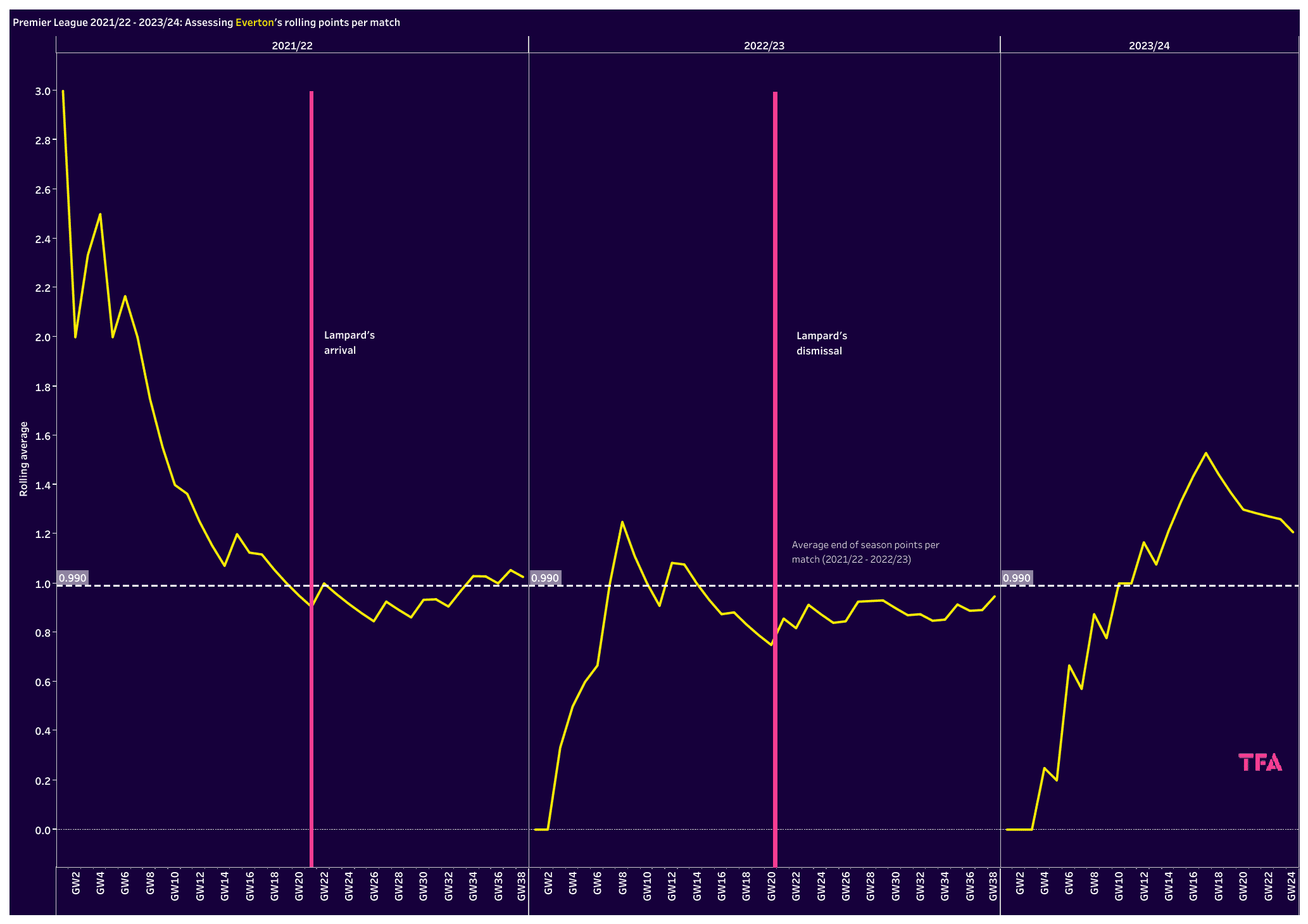
The above graph shows the average points for the Toffees at the end of the past two seasons combined, which is 0.99 points per match.
As shown in the graph, Lampard was underperforming in relation to this value at times, as well as outperforming this value, similar to Dyche.
As Dyche has overperformed at times this campaign, Everton is currently in a downward spiral towards their average.
Therefore, it shows that changing managers mid-season doesn’t have a long-term impact, as points per match will regress to the mean.
While it has been shown that Everton have been no better off since Lampard’s dismissal, Lampard’s decision to return to Chelsea on an interim basis last season has been a detriment to his managerial career.
However, as the rest of this analysis will show, there were indeed positives to the former midfielder’s early managerial days to highlight why he shouldn’t pull the plug on management just yet.
Developing youth
Throughout his managerial career, Lampard has been known for giving opportunities to younger players, as testified in the graph below, which depicts the number of players 21 or under who have featured under Lampard.
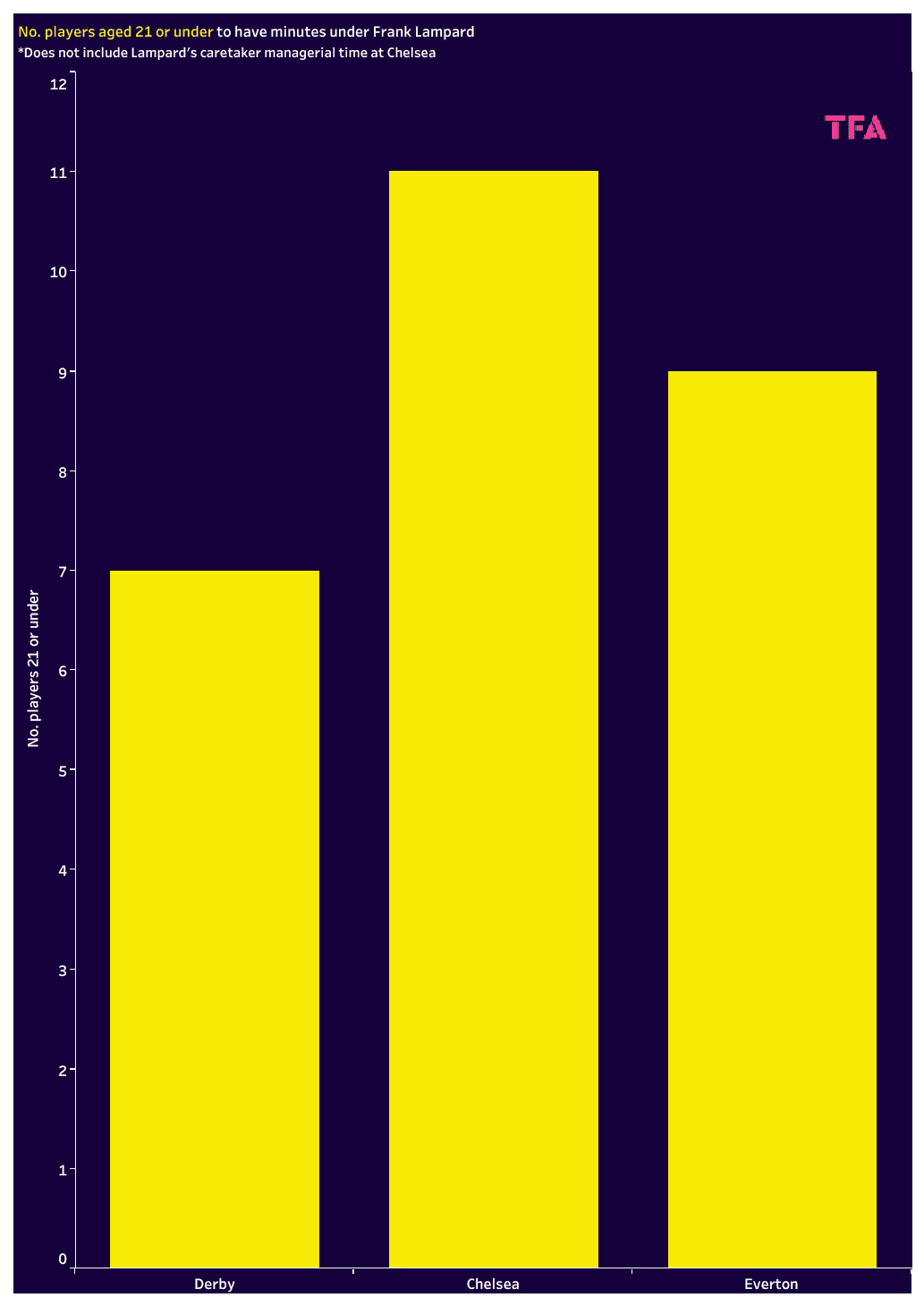
The injection of youth players within the Chelsea set-up was unusual at the time.
While some may argue that the transfer embargo triggered such an injection, Lampard still had the conviction to put faith in those players.
In March 2020, he set a record by giving more first-team opportunities to Academy graduates than any other manager in Chelsea’s history.
These players include some now highly established personnel, such as current club captain Reece James, Serie A stars Tammy Abraham and Fikayo Tomori, Brighton midfielder Billy Gilmour, and recent Manchester United signing Mason Mount.
Mount, particularly, was a huge part of Lampard’s first managerial spell at Stamford Bridge, in addition to his time at Derby.
Mason Mount Ball Progression Map
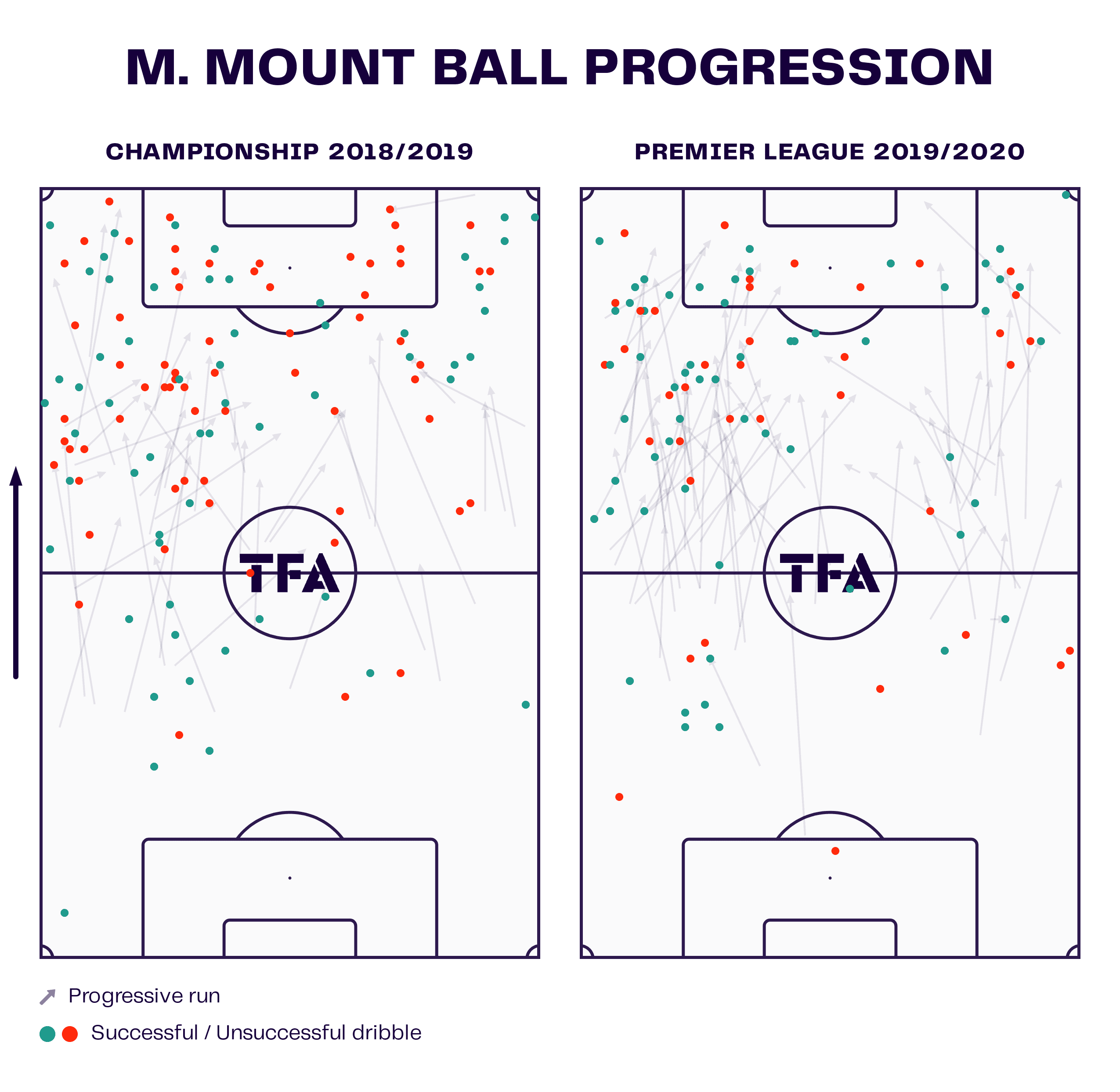
The graphic details how much Mount drove on his respective sides when plying his trade in England’s first and second tiers.
From the above, it is noticeable that despite an immediate step up the divisions, Mount’s attacking outlet improved at Chelsea, driving play into the opposition penalty area more often.
Mount was a key player in the Lampard era in West London, often triggering Chelsea’s offensive strategy.
When leading the press, the midfielder would look to instigate attacking movements, whether in possession or off the ball.
The then-21-year-old’s energy, speed, and technical ability shone through as his versatility and ability to turn on the ball to drive play forward was commonplace.
Had Lampard not instilled faith in Mount, Chelsea would likely not have been able to demand a reported £55 million fee for the midfielder from United.
Given the noose of financial fair play, it has since proven valuable for the Blues.
However, Mount’s form has suffered in recent seasons, and he has struggled for game time at Old Trafford, not helped by injury.
This only strengthens Lampard’s positive influence on Mount’s performance level further.
In addition to Lampard’s impact on the Cobham graduates, he has also aided other players in their professional development, such as now Fulham midfielder Harry Wilson.
Wilson, a loanee at Derby under Lampard, has previously spoken of how the former England midfielder improved his game.
Although Wilson thrives on the right wing and can play with greater freedom in this position, Lampard utilised the former Liverpool player in central midfield due to a piling injury list at Pride Park at the time.
Despite Wilson’s unfamiliarity with the role, he has noted how it aided his tactical awareness, and Lampard gave the youngster confidence that he could play it well.
Since moving to Craven Cottage, Wilson has predominantly played on the right of the forward line, but in the EFL Cup fixture against Norwich City this season, he did line up in a midfield three in a 4-3-3 formation.
It goes to show that Wilson’s versatility is paying off at his current club, and without Lampard, it may not have been possible.
Another string to the Welshman’s bow was certainly added due to Lampard’s management.
Lampard’s tactical philosophy and lessons to be learned
Over the seasons, Frank Lampard’s style of play has been flexible in formation choice, but in the earlier days of his managerial career, he would tend to switch between 4-2-3-1 and 4-3-3 formations.
During his time at Derby and his first spell at Chelsea, his sides were possession-heavy and were known for fluid attacking movements.
Lampard would look to create a balance in the attacking phases and utilise the width of the pitch.
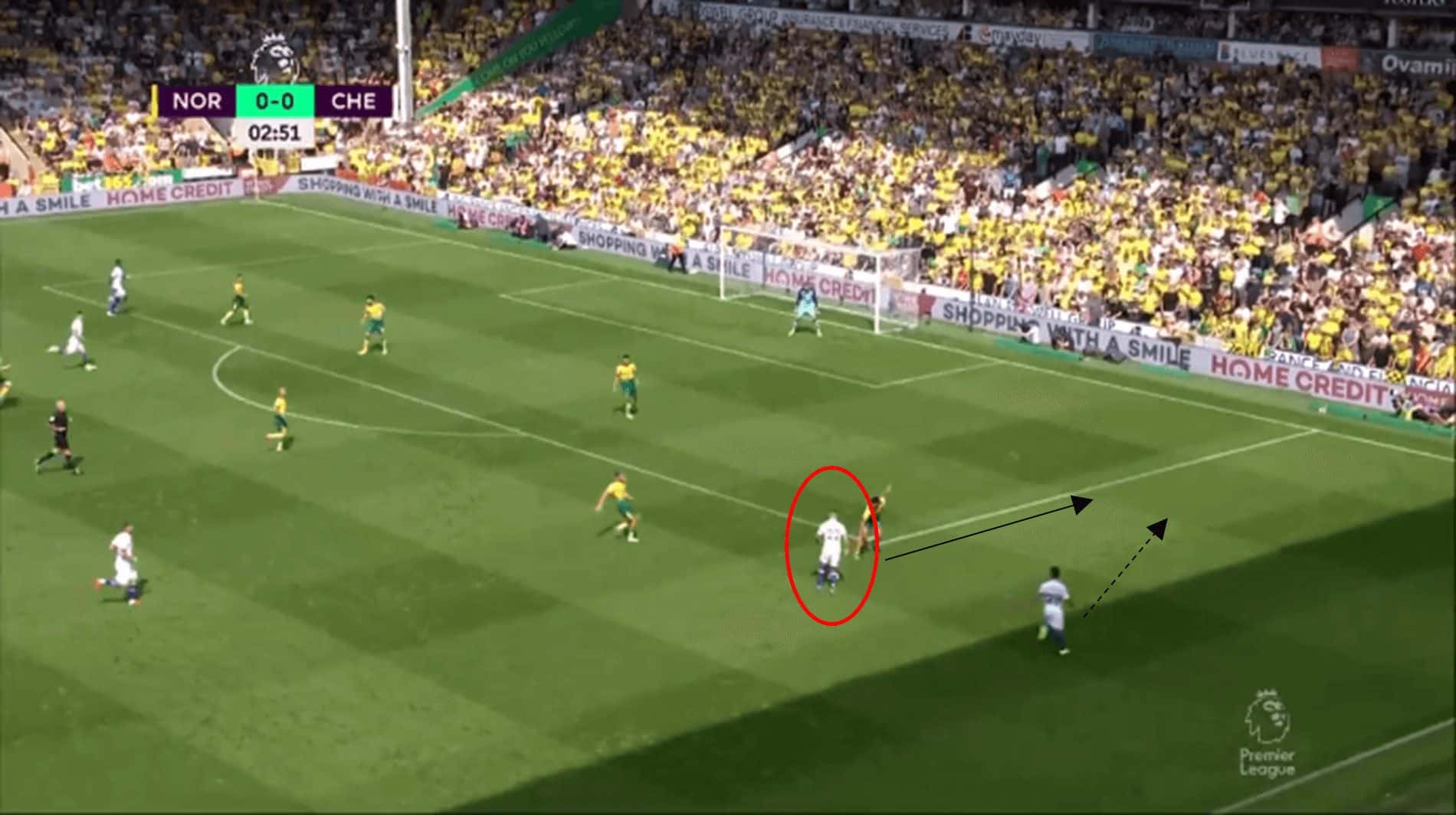
Above, a classic example is seen: a forward player would look to invert inside, while a full-back would make overlapping runs.
The quick feet of the forward ensured space for the said full-back on the wing to provide crosses into the area.
This is precisely the case here against Norwich, where Christian Pulisic plays in the overlapping César Azpilicueta, who provides an assist for Tammy Abraham.
It’s no coincidence that with this style of play, Chelsea ended up topping the league charts for crosses into the penalty area per 90 in Lampard’s first season in charge, averaging 2.84 per 90.
This style further suited the Blues as they had the personnel to execute the tactics well.
For instance, Callum Hudson-Odi and Willian both ranked in the top three in the division for progressive carries per 90 for players to have featured at least five 90s.
Such strong carriers of the ball enabled Chelsea to carve out opportunities, creating options through the centre and dragging the opponents out of position to create openings on the wing.
Lampard’s sides adopted a strong press in the early days when out of possession.
The Blues would look to stifle opponents and use the strengths of their midfield three to regain possession in the middle of the pitch.
In Lampard’s first season in charge in West London, only Bournemouth averaged more interceptions per 90 minutes.
Chelsea’s high interception rate was primarily due to the influence of midfielders Jorginho and N’Golo Kanté, who both ranked in the division’s top 10 players to have featured at least five 90s for interceptions per 90.
However, the tide turned during Lampard’s second season at the Blues.
While his formation and principles remained largely the same, opponents were too often finding ways to penetrate Chelsea’s central areas, particularly on the break.
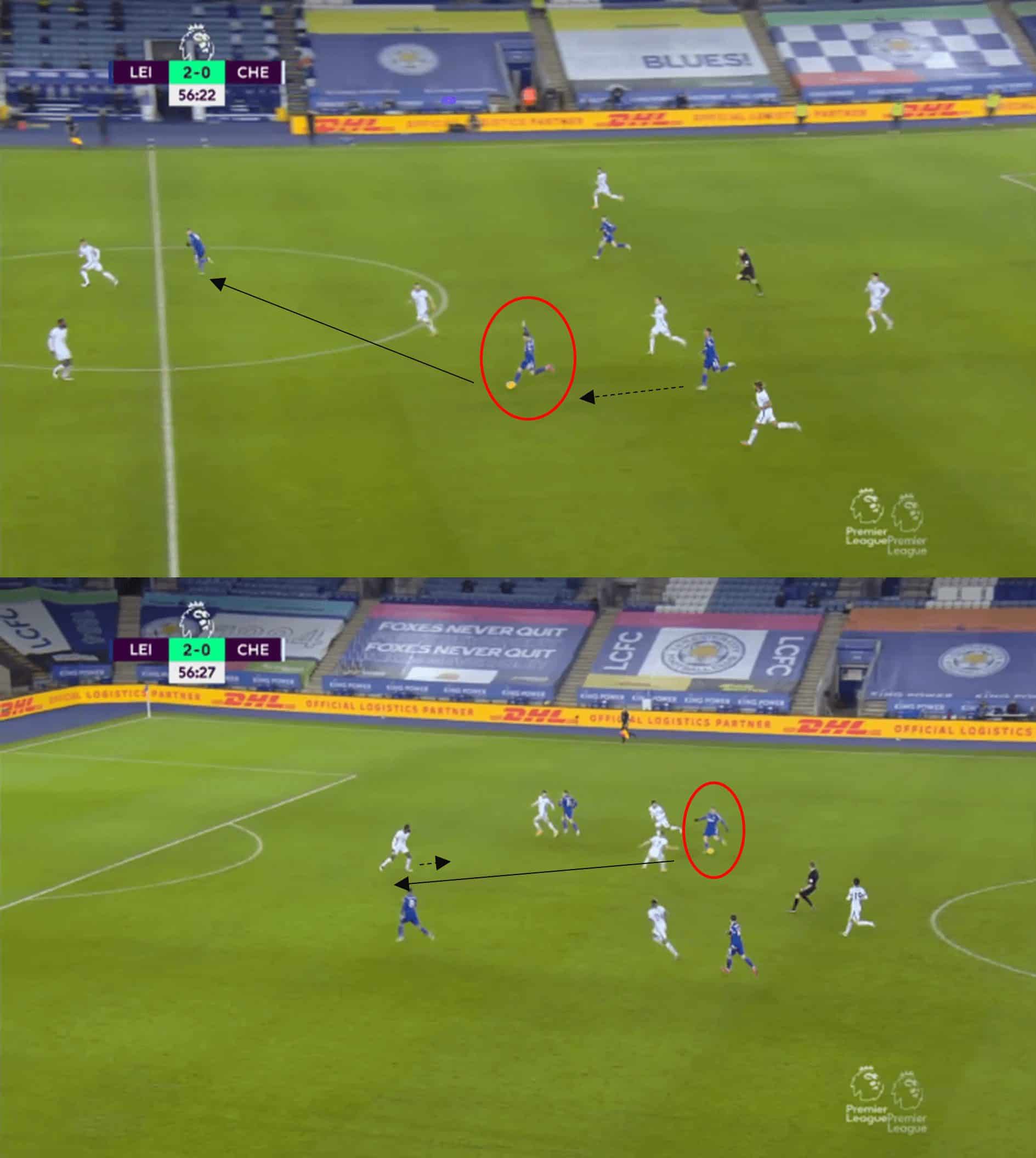
Leicester is shown catching Chelsea on the break, as only the centre-backs are left to cover in the defence.
However, as Antonio Rüdiger is drawn towards the ball, Youri Tielemans is left with acres of space to run into.
The Belgian is able to get an effort on goal, having outsprinted the Blues midfield.
This match proved to be Lampard’s last league game in the Chelsea dugout as his side went on a miserable run of losing five in eight league games.
When Lampard returned to management at Everton, he regularly changed formation with little success.
However, credit to Lampard.
As the season approached the business end of the campaign and survival was on the line, the former England midfielder adopted a less expressive approach and switched to a 5-4-1 in back-to-back fixtures against his former side, Chelsea, Leicester, and Watford.
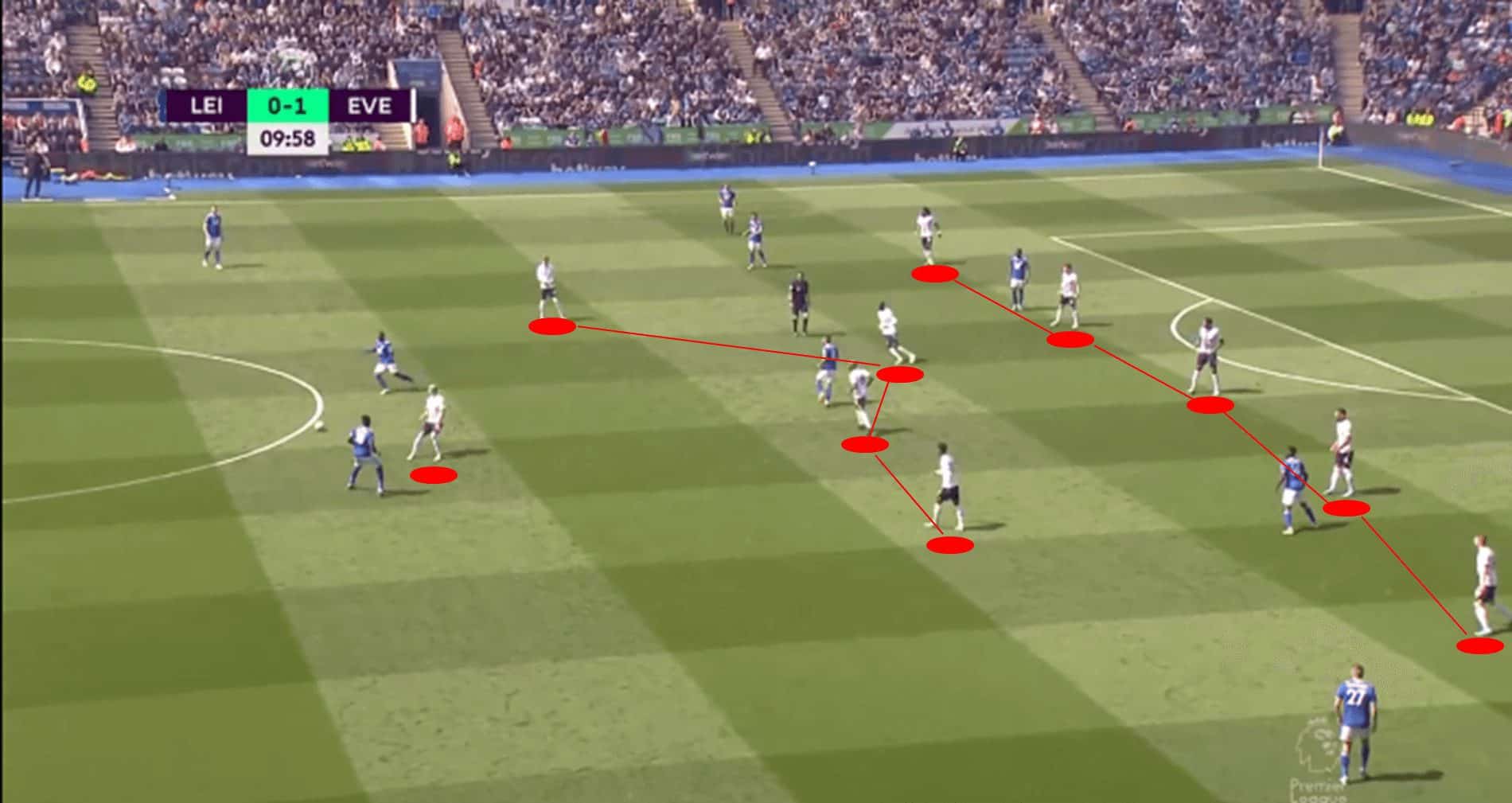
The Merseyside outfit became compact in shape and less aggressive with their press, instead dropping deeper, as seen in the match.
In these fixtures, Everton surrendered possession, having less than 40% of the play against Chelsea and Leicester.
Whilst it wasn’t a system that facilitated the most attractive football, it was effective.
Lampard’s side was organised without the ball and conservative with it, picking the right moments to launch counterattacks.
The change in tact had the desired end product as the Toffees won both matches, and it would kickstart a run of winning three of the last six to ensure Premier League survival.
With safety ensured, the Everton faithful expected Project Lampard to begin; however, this proved not to be the case.
Lampard experimented with the team shape as the new season got underway but generally opted for his preferred 4-3-3 formation.
However, his Everton side lacked the same level of quality as his previous Chelsea side.
Although the Toffees showed flashes of good attacking play, their overall possessional play was not up to the same standard.
A common theme was that Everton would lose possession in the middle third of the pitch.
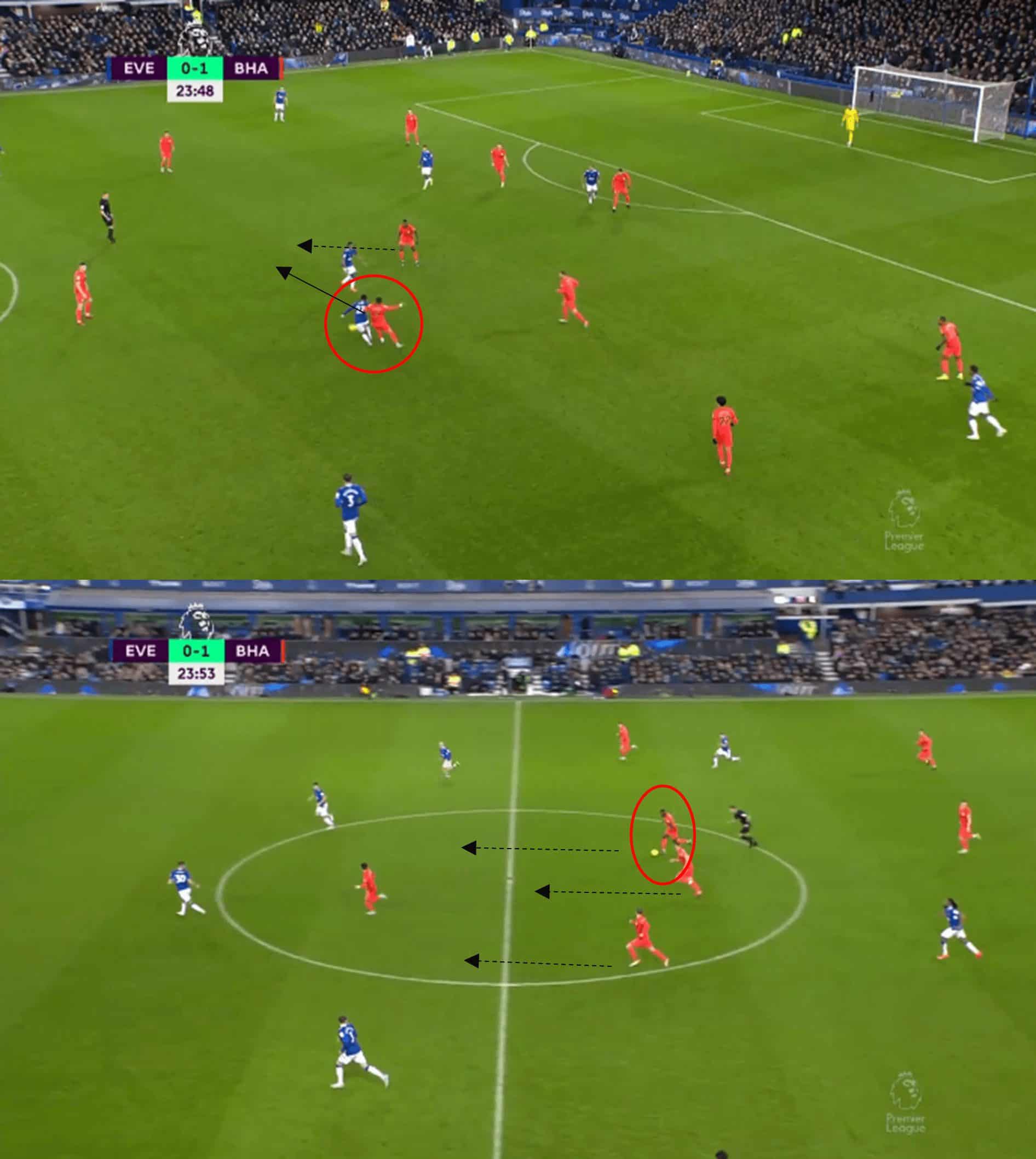
A prime example is shown above: Brighton wins the ball back and is given a license to run straight at an exposed Everton backline.
The gaps in the Everton midfield continued to open up as their high press proved fruitless.
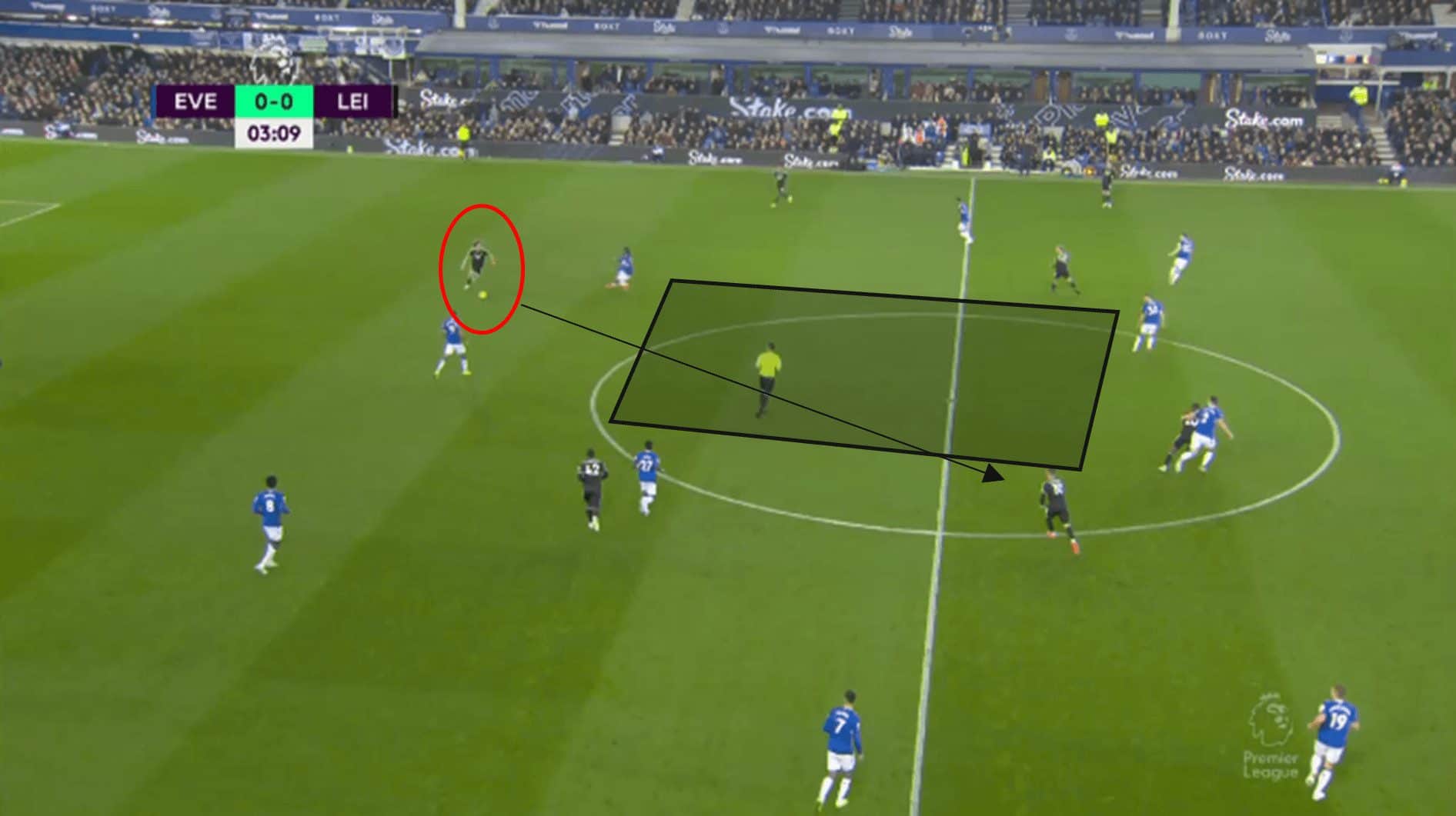
An aggressive press by Everton caused the midfield to be out of position, and as Alex Iwobi attempted to put pressure on the opposition’s defence, a sizeable gap was created in the midfield.
Leicester exploited this, driving at the Everton defence centrally and eventually getting a shot away.
Although commendable to aspire to play possession-based football, there was a sense of naivety.
If a squad does not have the personnel, it can become a dangerous game.
Although not as pleasing on the eye, had Lampard stuck with five at the back, he may have found a way to carve out results.
However, the reality is that Everton was probably never the right choice for Lampard.
It was probably too big of a task for a young manager still learning, especially to build a project given their current financial plight.
A project, though, is precisely what Lampard needs.
It will be a case of finding the right club that fits the bill.
Conclusion
At still a young age, Lampard could still have his best managerial days ahead of him, as this tactical analysis has shown his ability to nurture younger players.
Moreover, it has been shown that, particularly in his earlier management days, Lampard adopted attractive possession-based football, winning plaudits.
While defensive frailties have been unearthed during his time in the dugout, these should serve as learning curves.
His current sabbatical from the game may be a blessing as it allows the former midfielder to assess his options rather than immediately fill a vacancy.
At times, it has felt like he has been the right man for the job but at the wrong time.
There is a heightened sense of pressure that his next appointment will be crucial.
Lampard may need to accept that dropping down the divisions may be the answer.
In doing so, Project Lampard may very well commence.






Comments